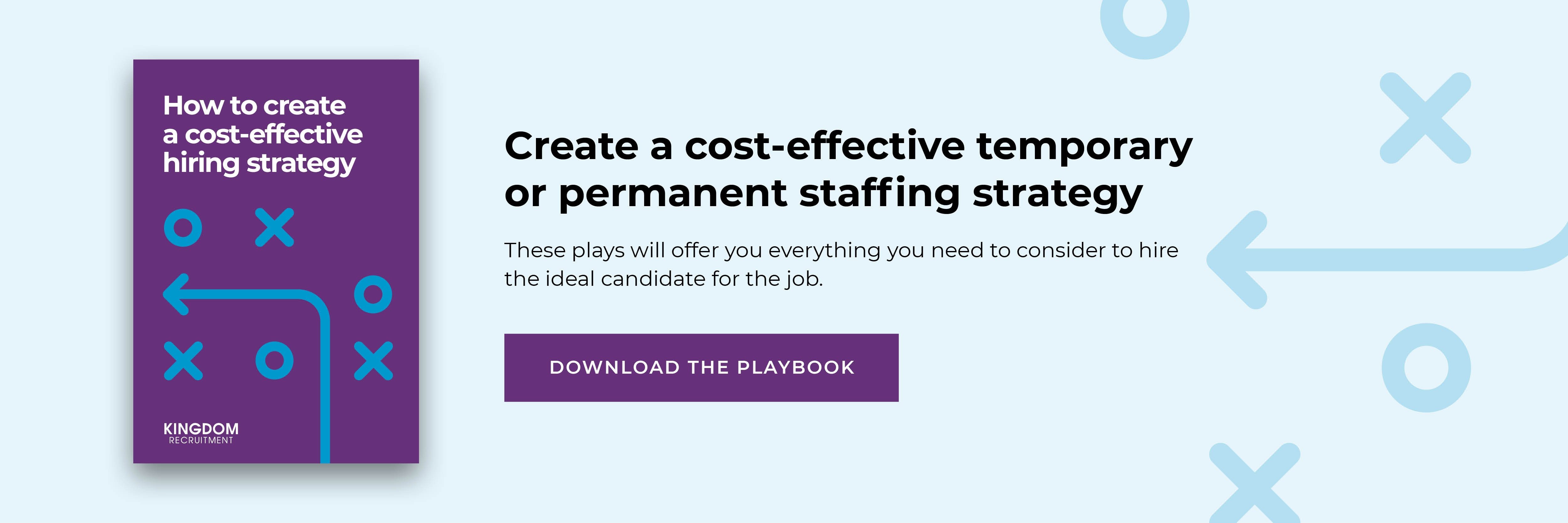Knowing your current staffing situation and your future staffing needs is essential to fulfilling short and long-term goals. To assure your business is always prepared for current and future requirements, a staffing plan is essential.
.jpeg?width=5472&name=dylan-gillis-KdeqA3aTnBY-unsplash%20(1).jpeg)
Here’s what a staffing plan is, how you can identify staffing needs and how you can create a robust, reliable staffing plan.
What is a staffing plan?
A staffing plan involves a company assessing and identifying the staffing needs of an organisation. It’s a strategic planning process that enables companies to understand the number and types of employees they need to accomplish their short and long-term goals.
A good staffing plan will help you identify:
- The skills gaps you need to fill
- The work that needs doing
- How many people you need to employ
- The skills and experience you need to complete the work
A good strategic staffing plan should be able to encompass an entire company or even smaller departments if needed.
What are the benefits of a staffing plan?
With a well-researched staffing plan, a company can prepare relevant departments for growth. This will ensure the right people with the right skills are brought into the company at all the right times.
Not only that, but a staffing plan also helps businesses to:
- Reduce labour costs and maximise productivity
- Increase employee engagement
- Increase employee retention and happiness
- Reduce and eliminate skills gaps
- Streamline business growth
With a robust staffing plan in place, you can prevent issues that could hinder growth. These plans also help companies make budgeting and financial decisions within the organisation.
How to create a staffing plan
Creating a staffing plan involves three steps:
- Determine current staffing needs
- Forecast future staffing needs
- Identify the gaps between the two
After assessing staffing needs, you need to determine the recommendations on how to address those needs. For example, this might include recruiting new talent, promoting roles internally or providing more training and development for employees.
How to calculate staffing needs
Before creating the plan, knowing the overarching goals for the business is vital. These are usually found in a business’ strategic plan. With these goals at hand, you can clarify objectives and create the staffing plan accordingly.
For example, strategic business plans may involve opening a new location, requiring current staff to move or new employees to be hired, which can be planned for in advance.
Next, you can determine the company’s current staffing situation. To do this, consolidate all personnel data into one source to ensure it can be properly assessed. Pay particular attention to the following:
- The number of employees
- Team size and who works where
- Skills within the workforce
- High performers and potential leaders
- Low performers and people who may indicate turnover
- Staff age
With this data, companies can better understand their current staffing situation and therefore, they can more accurately identify staffing needs later down the line.
Calculate future staffing needs
A variety of internal and external factors can affect staffing needs. To calculate future staffing needs, consider the following factors:
- Business goals
- Turnover and projections
- Expected mergers and acquisitions
- Labour costs
- Product launches
- Competitors attracting and recruiting talent
- Changes to the economy
- Unemployment rate
Trend analysis
Trend analysis is ideal for established businesses as it uses historical data to help determine future needs. To perform a trend analysis, you should gather data for at least the past five years. The following should be connected:
- Hiring and retirement patterns
- Employee turnover
- Education
- Skills and qualifications
- Years of service
- Transfers
- Promotions
- Employee demographics
With this data, your company can analyse it, understand turnover rates over time and determine trends.
Ratio analysis
A ratio analysis is a forecasting method that predicts staffing demand and compares forecasting results against the industry standard.
Ratio analysis is particularly useful for younger companies as it doesn’t rely on historical data to predict future requirements. It establishes a relationship between future sales revenue predictions and staffing requirements.
To calculate this, determine the ratio between sales revenue and staff. This is done by dividing current sales revenue by the current number of sales employees.
With this ratio, gaps in staffing can be identified.
Gap analysis
At this stage, compare current and staffing needs for gaps. This means looking at where your company’s staff is now and where it needs to be. Here, you can identify discrepancies, whether you need more staff and if any skills are missing from the current workforce to meet future business goals.
Make a staffing plan
Now, the staffing needs analysis has been completed and it’s time to make the staffing plan. This could include recommendations to provide training sessions to address skills gaps or develop succession policies following retirements or promotions.
This process should involve the business’ leaders to make a strategic plan that addresses staffing needs and the company’s goals, culture and mission.
Our new playbook will help you create a cost-effective hiring strategy and offer everything you need to consider to hire the ideal candidate for the job. Take a look below.
Discover how to create a cost-effective hiring strategy
Creating an effective hiring strategy is essential to business success. This strategy needs to determine who you’re going to hire someone, how you’ll hire them and when. The playbook is packed full of plays, tips and advice with topics ranging from creating a successful onboarding plan, measuring employee satisfaction levels, building your workforce plan and much more.
To get started and access these insights, click the button below today.

%20(1).jpeg?width=7677&quality=low)
%20(1).jpeg)